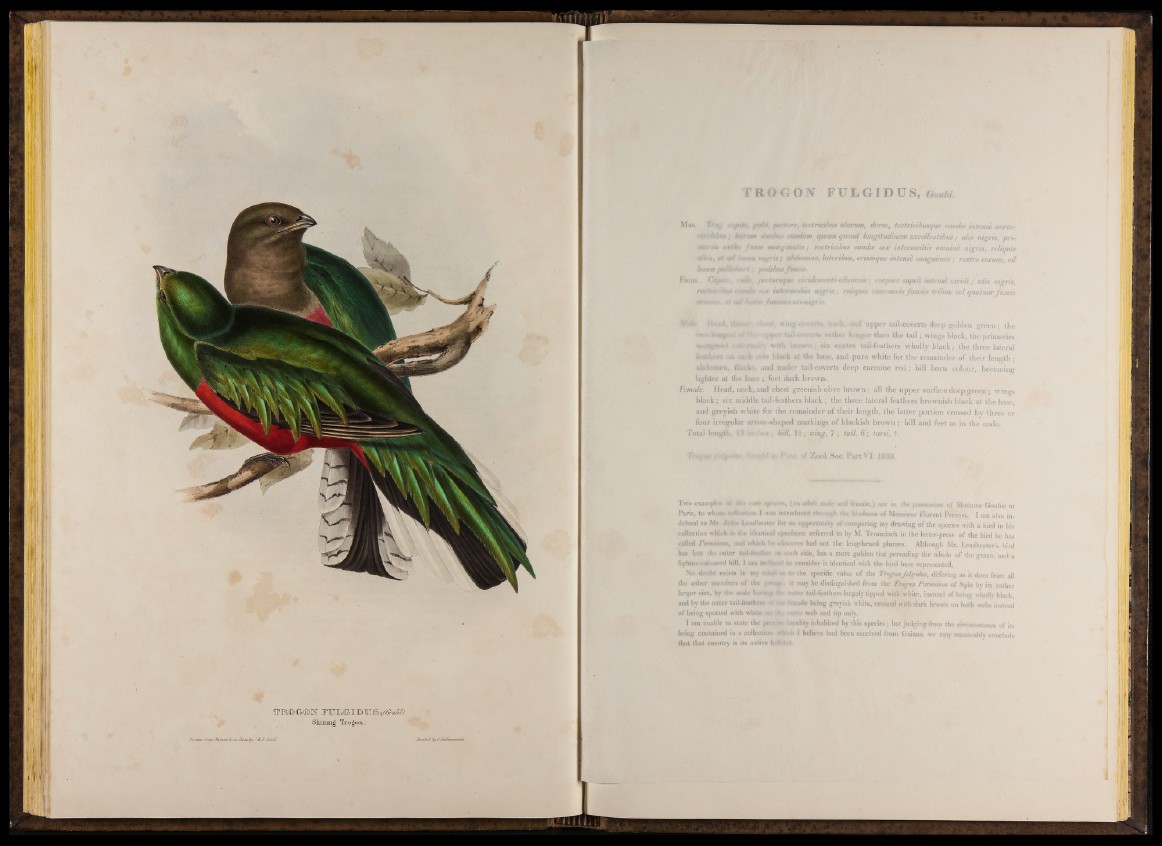
T B .0 <&©E" F U L G I P U S
Shining Trogon.
TROGON FULGIDUS , Oouki,
Mas. xHtg mpite, guiú, pastare, tectricibus alarum, dorso, tectricibusque cauda; intense atireo-
vmmbus; harum dmdms caudam ipsam quoad longitudinem excellentibus; alis nigris, prismrm
e xtm fm co rmrgimtis; rectricibus caudce sex intermediis omninb nigris, reliquis
albis, et ad ¡¿mm nigris; abdomine, lateribus, crissoque intensé sanguineis; rostro corneo, ad
basin p&lltrkore; pedibusfma*
Fcem. Cfípipi\. <:■:<■&}. pectoreque viridewnti-olivaceis; corpora supra intense viridi; alis nigris
rcctrw*bm mat intermediis nigris; reliquis cineraceis fa s cm tribus vel quatuor Jtiscis
ar&it'-f-., ét. ad fusce*n't yiti-Hig**x.
‘KKm H®a<Í» fevws&, mu* upper tail-covert« deep golden green; the
tw'o t*f # ,;v '•■■jpper tail-«© vert» rathe» longer than the ta il; wings black, the primaries
imcgd&á zmm u á iy with brown; six ©entre tail-feathers wholly black; the three lateral
Iw®*** on emh -sde black at the base, and pure white for the remainder of their length ;
abdomen, flanks, and under tail-coverts deep carmine red ; bill horn colour, becoming
lighter at the base ; feet dark brown.
Female. Head, neck, and chest greenish olive brown; all the upper surface deep green ; wings
black; six middle tail-feathers black; the three lateral feathers brownish black at the base
and greyish white for the remainder of their length, the latter portion crossed by three or
four irregular arrow-shaped markings of blackish brown ; bill and feet as in the male.
Total length, 13 t&dbg* : bill, K-; using, 7 ; tail, 6 ; tarsi, f.
0 &&jt*r< í-Hí-íáM m P ••V <>f Zool. Soc. Part VI. 18381
Two examples # £&'*s rare species, (ait adufe mate aad frtnale,) are in the jtossession of Madame Goubie at
Paris, to whose citation I was introduced through the kindness of Monsieur Floreot Prevost. I am also indebted
to Mr. Jefen Leadheater for an opportunity of comparing my drawing of the species with a bird in bis
collection which w the identical specimen referred to by M. Temminck in the letter-press of the bird he has
called Pamninus, awl which he observes had not the lengthened plumes. Although Mr. Leadbeater’s bird
has lost the outer feuMealher flit each side, has a more golden tint pervading the whole of the green, and a
lighter-e<d«Mired bill, I am in«-4w«sd to consider it identical with the bird here represented.
No doubt exists in mv mind M to the specific value of the Trogon fulgidus, differing as it does from all
the other members of the ¡¿roup. it may be distinguished from the Trogon Pamninus of Spix by its rather
larger size, by the male having tfcr outer tail-feathers.largely tipped with white, instead of being wholly black,
and by the outer tail-feathers ^ ¡hr fen «ale being greyish white, crossed with dark brown on both webs instead
of being spotted with white ov mter web and tip only.
I am unable to state the precW locality inhabited by this species; but judging from the circumstance of its
being contained in a collection «fetch I believe bad been received from Guiana, we may reasonably conclude
that that country is its native hflfestot.